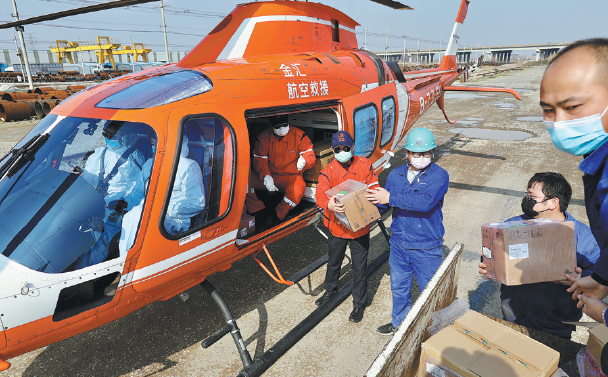


Workers from Wuhan Iron and Steel (Group) Corp transport supplies to a helicopter in Wuhan, Hubei province, on Sunday. The urgently needed supplies, including protective clothing, respirators and protective goggles, were then delivered to Hubei General Hospital. ZHU XINGXIN / CHINA DAILY
Exhibition halls, stadium converted to receive patients with mild symptoms
Building temporary hospitals is a major measure to help prevent and control novel coronavirus pneumonia in Wuhan during the period of combating the highly infectious disease, a top medical expert said.
"Wuhan is at war," Wang Chen, president of the Chinese Academy of Medical Sciences, told China Daily over the weekend.
"We hope the temporary hospitals will become a Noah's Ark that carries the health and safety of patients, their families, the communities and the whole of society."
Wuhan, the epicenter of the NCP outbreak, started to build the first three temporary hospitals on Feb 3 to ease shortage of beds for patients with the virus. The hospitals, converted from two exhibition halls and a sports stadium, started to receive patients on Wednesday night, and will accommodate more than 4,000 patients on their completion.
More such hospitals will be built and will eventually provide more than 10,000 beds, according to the city government.
Wuhan, capital of Hubei province and the biggest city in Central China, is the worst-hit city by the virus outbreak in China, resulting in a severe shortage of beds in regular hospitals due to the rapidly increasing number of patients. Many residents with mild symptoms used to stay in quarantine at home instead of in hospitals for treatment due to reasons such as a shortage of beds or fear of cross-infection.
The number of confirmed cases in the city reached nearly 15,000 as of late Saturday night — more than 40 percent of all cases on the Chinese mainland — an increase of nearly 1,400 over the day before, the provincial health authority said on Sunday.
In addition to building temporary hospitals, authorities have recently accelerated transforming hotels, training centers and college dormitories into places for the quarantine and treatment of patients with NCP.
"Although the temporary hospitals are not as well equipped as regular hospitals, they are suitable for patients with mild symptoms," said Wang, who is also vice-president of the Chinese Academy of Engineering and a respiratory expert.
Patients can be separated from their family members and communities by staying in the hospitals to prevent the spread of the disease, he said. In addition, they can get medical monitoring and care in these hospitals, and be immediately transferred to designated hospitals for treatment if their condition worsens, Wang said.
"A temporary hospital is like a big community of NCP patients with mild symptoms," he said. "They can live together for a certain period of time, and can go back home safely after they test negative for the virus."
Zhang Junjian, president of the temporary hospital in the Wuhan Parlor exhibition center, said it will be able to accommodate 2,000 patients when its construction is completed. It has already received more than 600 patients.
"Only through building such hospitals can we accommodate large numbers of patients in a very short time," he said.
On Saturday afternoon, construction of the hospital was underway, and in one section of an exhibition hall partition walls had been erected that enclose rows of beds prepared for patients. The beds are organized orderly and evenly, in single or bunk beds, with about 1 meter between the beds.
At a public area in the hall instant food and snacks such as instant noodles and bottled water are available.
Outside the hall were a line of tents temporarily built for purposes such as outpatient services and monitoring.
While leading a team organized by the central government to inspect Hubei province, including Wuhan, on its disease control and prevention over the past few days, Vice-Premier Sun Chunlan instructed local authorities to receive all patients and those such as close contacts of confirmed patients.
The team has also organized more than 11,000 medical workers from across China to send them to Wuhan to help combat the outbreak.
While visiting Leishenshan Hospital in Wuhan, which was specially built to receive patients with NCP, on Saturday, Sun urged the hospital to race against time to treat patients and ensure more patients can receive treatment.
Meanwhile, measures should be taken to ensure the safety of medical staff, she said.

 Award-winning photos show poverty reduction achievements in NE China's Jilin province
Award-winning photos show poverty reduction achievements in NE China's Jilin province People dance to greet advent of New Year in Ameiqituo Town, Guizhou
People dance to greet advent of New Year in Ameiqituo Town, Guizhou Fire brigade in Shanghai holds group wedding
Fire brigade in Shanghai holds group wedding Tourists enjoy ice sculptures in Datan Town, north China
Tourists enjoy ice sculptures in Datan Town, north China Sunset scenery of Dayan Pagoda in Xi'an
Sunset scenery of Dayan Pagoda in Xi'an Tourists have fun at scenic spot in Nanlong Town, NW China
Tourists have fun at scenic spot in Nanlong Town, NW China Harbin attracts tourists by making best use of ice in winter
Harbin attracts tourists by making best use of ice in winter In pics: FIS Alpine Ski Women's World Cup Slalom
In pics: FIS Alpine Ski Women's World Cup Slalom Black-necked cranes rest at reservoir in Lhunzhub County, Lhasa
Black-necked cranes rest at reservoir in Lhunzhub County, Lhasa China's FAST telescope will be available to foreign scientists in April
China's FAST telescope will be available to foreign scientists in April